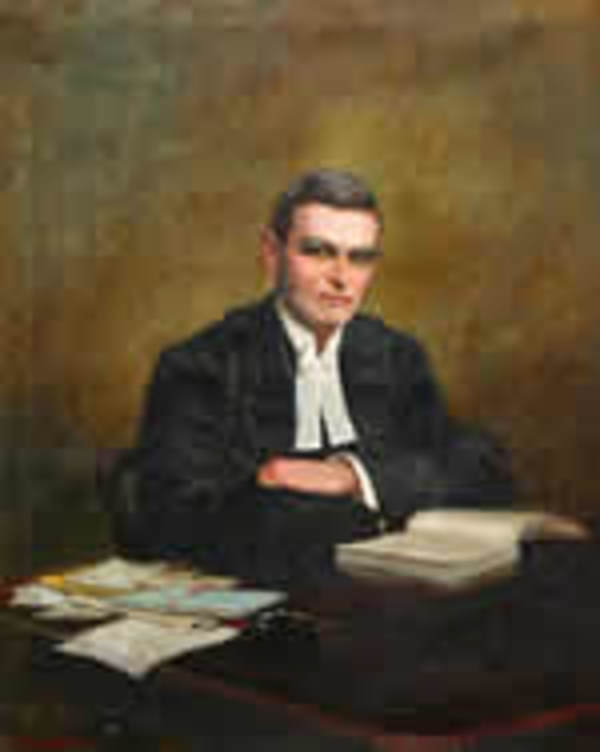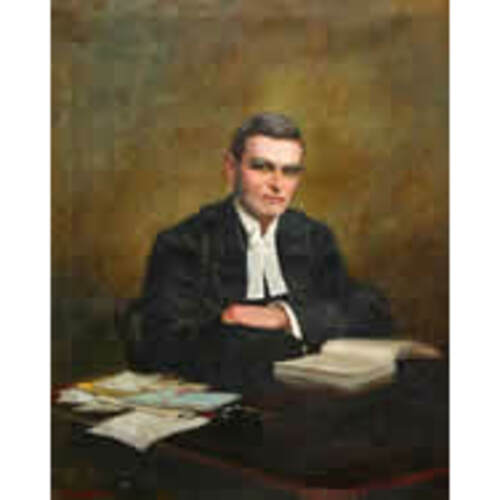
Source: Link
GRAHAM, Sir WALLACE NESBIT, lawyer and judge; b. 15 Jan. 1848 in Antigonish, N.S., son of David Graham and Mary Elizabeth Bigelow; m. 16 June 1875 Annie M. Lyons (d. 1926) in Cornwallis, N.S., and they had two daughters and one son who survived to adulthood; d. 12 Oct. 1917 in Halifax.
The son of a successful sea-captain, farmer, and shipbuilder, Wallace Graham saw five of his six brothers follow the paternal pattern. He alone went to university, graduating from Acadia College in Wolfville, N.S., in 1867. After articling in Antigonish for a year, he served his remaining three years with Samuel Leonard Shannon* of Halifax and was called to the bar of Nova Scotia on 9 Dec. 1871.
Accepting the offer of a partnership with fellow Acadia graduate Robert Linton Weatherbe in 1872 marked a crucial step in Graham’s career. This partnership would expand to become a nursery of giants, producing three chief justices of Nova Scotia and two prime ministers. Robert Laird Borden* articled with Weatherbe and Graham in 1874–78 and returned as a partner when John Sparrow David Thompson* went to the bench in 1882. Thompson himself had joined Graham after Weatherbe went to the Supreme Court of Nova Scotia in 1878. The two new partners, so similar in temperament, remained lifelong friends.
Thompson and Graham agreed with Sir Charles Tupper in 1881 to take on young Charles Hibbert Tupper* in return for their firm’s appointment as agent of the Department of Justice in Halifax. (Graham also received a dominion qc in 1881, perhaps no coincidence.) C. H. Tupper’s election to the House of Commons in 1882 removed him from much day-to-day business, but Borden contributed so substantially to the firm that in 1885 or 1886 William Frederick Parker was hired as an associate to assist with the extra work. Thus, before Tupper’s withdrawal in 1888, the firm was nominally four men strong, with three fully employed. The original partnership of Weatherbe and Graham had become a small modern law firm, complete with the distinction between profit-sharing “partners” and salaried “associates.” The stimulus of the National Policy and the rise in corporate business had created demands that the traditional forms of delivery of legal services – the sole practitioner and the two-man partnership – could not meet. Graham’s firm, like Robert Sedgewick*’s, was one of the first in the Maritimes and among the first in Canada to respond to these demands by adopting new forms of business organization.
Graham’s contribution to the renaissance of legal professionalism in late Victorian Nova Scotia was profound. He lectured at the new Dalhousie law school in marine insurance and bills and notes, and served on commissions which produced revisions of both the federal (1886) and the provincial (1900) statutes. His five years on the council of the Nova Scotia Barristers’ Society (1881–86) came just as it was transforming its structures of governance and claiming to speak for all lawyers in the province; he was elected president for 1887.
Forceful yet controlled as a litigator, Graham was similar to Borden and Thompson in style, his approach far removed from the florid eloquence of Weatherbe and his generation. He appeared frequently before the Supreme Court of Canada and on occasion argued before the Judicial Committee of the Privy Council in London. In 1887–88 he assisted John Thompson, now minister of justice, in Washington, presenting the British case before the joint high commission on the Atlantic fisheries. He was especially sought after in matters of marine law, and had acted for the federal government in the seizure of American fishing vessels in 1886.
Thompson considered Graham the ablest lawyer in the Maritimes, and recommended him to Prime Minister Sir John A. Macdonald* for a place on the Supreme Court of Canada when William Alexander Henry* died in 1888. An offer was not made, but Graham would not likely have left Halifax. He had declined Thompson’s offer of nomination as deputy minister of justice, but agreed to accept a place on the Supreme Court of Nova Scotia. When Alexander James died, Graham’s appointment as puisne judge and judge in equity was made immediately, on 24 Sept. 1889. Indifferent health and love of city and family made the local bench attractive to Graham. Acutely aware, moreover, of the low level of confidence in the court, he hoped to restore its fallen reputation.
In highly uncharacteristic fashion, Graham’s appointment was greeted positively even by Halifax’s Liberal Morning Chronicle. It looked forward to a “large degree of judicial impartiality,” since Graham had seemed “to hold the reins pretty fairly between the two political parties.” Graham’s political views in the 1870s are unknown, but he had been perceived as a Liberal because of his partnership with Weatherbe. Despite his subsequent professional association with prominent Conservatives, his federal appointments in the 1880s provoked cries of outrage from Conservative lawyers in Halifax. Charles Tupper advised Sir John A. Macdonald that Graham was in fact a member of the Liberal-Conservative party, and justified this use of patronage as a recompense for Charles Hibbert’s frequent absences from his Halifax firm for political reasons. In retrospect, it seems that the bar was more upset with the Tupper family’s arrogance than with Graham.
Graham’s reputation for hard work and painstaking accuracy is borne out by a perusal of his many reported decisions. As judge in equity, he was ex officio judge ordinary in the provincial Court of Divorce and Matrimonial Causes, which was empowered to grant divorces on the grounds of adultery and cruelty. He inherited an extremely conservative jurisprudence by prevailing Anglo-American standards, whereby only the gravest physical abuse would justify a divorce on grounds of cruelty. In two cases in 1907 and 1909 he managed to subvert this orthodoxy: in cases falling short of the threshold demanded for divorce, he would allow the wife a judicial separation. His “dual standard” for cruelty remained a tenet of provincial matrimonial law until overturned nearly 40 years later. One commentator has justly observed that Graham “offered a positive and substantial judicial response to the broken marriages facing him while at the same time maintaining the dominant judicial philosophy . . . regarding divorce.” Graham also inaugurated two important procedural changes: he allowed oral examination of witnesses, and he was willing to hear cases outside Halifax. In matters of child custody he did not hesitate to implement a provincial statute of 1893 which broke with traditions of paternal authority; after divorce he invariably awarded custody to the “innocent” party, whether male or female.
Upon the retirement of Chief Justice Sir Charles James Townshend*, Graham was elevated to the post on 19 April 1915. The traditional knighthood followed in 1916. One of the last cases he had dealt with before his elevation was the appeal by Harry Allen of his conviction for the murder of Nova Scotia’s first black lawyer, James Robinson Johnston. Allen’s appeal was allowed on 9 April, and Graham, then chief justice, presided over his second trial in October. The jury again convicted for wilful murder, but Graham recommended mercy in part because he felt it impossible for Allen to receive a fair trial in such a sensational case. Allen in the end spent 15 years in jail rather than 15 minutes on the gallows.
How successful Graham had been in enhancing the court’s reputation can be seen in the fact that the provincial government now began to have recourse to its judges for membership on royal commissions in sensitive matters. Graham chaired one such commission in 1914, which was struck to investigate the role of the attorney general, Orlando Tilestone Daniels, in the disposal of some surplus railway lands. The commission concluded that Daniels had had no corrupt motive in the affair but had been “gravely imprudent” in involving himself in an apparent conflict of interest. Twenty years earlier it would have been unimaginable for judges to articulate ethical standards for provincial politicians. The commission’s conclusions were apparently widely approved, for Daniels continued in office “with diminished respect,” as J. Murray Beck has noted.
The war overshadowed Graham’s two years as chief justice. It was everywhere around him on the day he died, without warning, in the fall of 1917. The following day conscription came into effect; Graham had been arranging for appeal tribunals under the Military Service Act on the eve of his death. Eight weeks later the Halifax explosion would lay waste to much of the city he loved. Graham’s two daughters had married British officers, and one of his sons-in-law was commanding a New Zealand regiment at the front. His son, who had become a prominent barrister in Regina, would die suddenly in 1919.
Wallace was said to be constrained and uneasy in manner. He had little charisma, but was deeply respected by the bar for his character, integrity, and ability. The Barristers’ Society demonstrated that respect by resolving to wear mourning for the month after his funeral. As a key figure in the translation of late-19th-century legal professionalism into the judicial arena, Wallace Graham well deserved that final tribute.
A paper by Wallace Nesbit Graham entitled “The fisheries of British North America and the United States fishermen” appears in Nova Scotia Hist. Soc., Coll. (Halifax), 14 (1910): 1–39.
Halifax County Court of Probate (Halifax), Estate papers, no.8648. NA, MG 26, A: 142997, 143017, 143021; D: 2292, 2731, 2750, 3051, 3064, 3249, 3696, 3713, 3813, 3927, 4380, 5582, 6009, 6105, 6177, 6360, 6543, 6702, 7138; F: 2571, 2583, 2585. PANS, MG 100, 170, no.28; RG 39, HX, M, 4, bar applications, no.26. Halifax Herald, 13 Oct. 1917. Morning Chronicle (Halifax), 25 Sept. 1889; 13, 15 Oct. 1917. J. M. Beck, Politics of Nova Scotia (2v., Tantallon, N.S., 1985–88), 2: 59. R. C. Brown, Robert Laird Borden, a biography (2v., Toronto, 1975–80), 1. Can., The revised statutes of Canada . . . 1886 (2v., Ottawa, 1887). Canada Supreme Court Reports (Ottawa), 1880–89. Clara Greco, “The superior court judiciary of Nova Scotia, 1754–1900: a collective biography,” in Essays in the history of Canadian law, ed. D. H. Flaherty et al. (7v. to date, [Toronto], 1981– ), vol.3 (Nova Scotia, ed. Philip Girard and Jim Phillips, 1990): 42–79. G. M. Haliburton, Clansmen of Nova Scotia (Halifax, 1979). N.S., The revised statutes of Nova Scotia, 1900, comp. W. [N.] Graham et al. (2v., Halifax, 1900). Nova Scotia Reports (Halifax), 1875–1917. James Snell, “Marital cruelty: women and the Nova Scotia divorce court,” Acadiensis (Fredericton), 18 (1988–89), no.1: 3–32. Waite, Man from Halifax. D. G. Whidden, The history of the town of Antigonish (Wolfville, N.S., 1934), 29–31.
Cite This Article
Philip Girard, “GRAHAM, Sir WALLACE NESBIT,” in Dictionary of Canadian Biography, vol. 14, University of Toronto/Université Laval, 2003–, accessed March 27, 2025, https://www.biographi.ca/en/bio/graham_wallace_nesbit_14E.html.
The citation above shows the format for footnotes and endnotes according to the Chicago manual of style (16th edition). Information to be used in other citation formats:
| Permalink: | https://www.biographi.ca/en/bio/graham_wallace_nesbit_14E.html |
| Author of Article: | Philip Girard |
| Title of Article: | GRAHAM, Sir WALLACE NESBIT |
| Publication Name: | Dictionary of Canadian Biography, vol. 14 |
| Publisher: | University of Toronto/Université Laval |
| Year of revision: | 1998 |
| Access Date: | March 27, 2025 |



